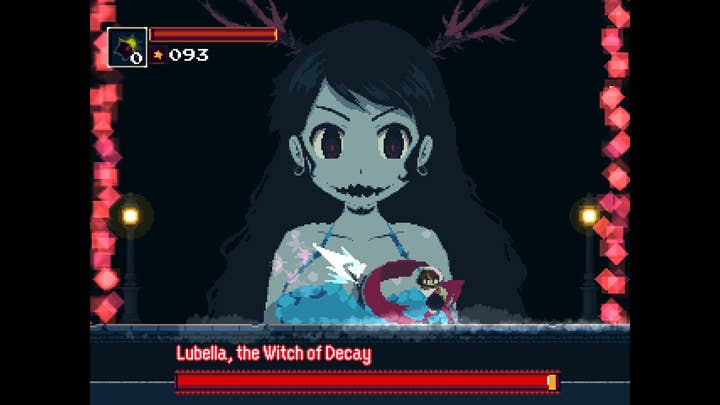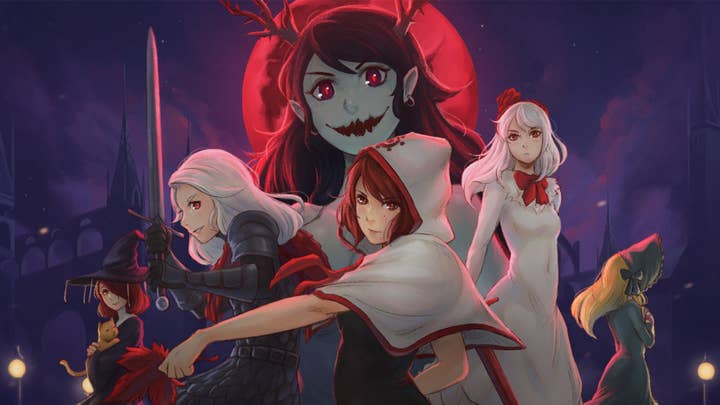Dangen Entertainment: What it really costs to run an indie publishing label
With the right focus and the right relationships, the Osaka-based publisher can find success with 10,000 units sold
For an independent game developer, the right publishing partner can mean the difference between a collaborative, creatively satisfying relationship and one that is frustrating and unfulfilling.
Publishers are play an increasingly large role in the indie game scene -- primarily in the form of a support unit whose job is to let the developer focus on what they do best, while they take care of everything that doesn't involve actually making the game. This could mean providing adequate funding, doing marketing and press, arranging resources for QA or a port to a different platform, and so on.
None of that comes cheap, especially when you're spending tens of thousands of dollars on a game that may or may not give you a return on your investment. For a publisher, the risk can be just as real and just as frightening as for the developer themselves. After all, your fate isn't your own hands when success depends to a large degree on how talented your development partners are. Any chance taken on an unproven developer needs to be planned for well in advance, and contingencies need to be in place for the very real possibility of several games under-performing in a row.
Running a publishing label is about a lot more than just having a love for games. It requires a keen understanding of the development process, including how the costs of developing games work out, and how to plan around them.
"Localizing a game with 100,000+ words is a huge decision to make from a risk analysis perspective"
Dan Stern
So, just what do the costs of running a fiscally responsible indie publishing label look like? I posed that same question to the staff at Dangen Entertainment, which is based out of Osaka, Japan. Dangen works with both Japanese and Western developers to bring their games to more platforms and markets, and its staff has a long history in development, localization, and marketing. In the two years since its founding, Dangen has leveraged its experience to bring games like Momodora to the Nintendo Switch, as well as localising Vestaria Saga, a game commonly believed to be developed by the original creator of Fire Emblem.
"I think [the cost of running] varies for every publisher, but for us the main expenditures are monthly salaries, trade shows and development costs," says Dan Stern, who handles developer relations for Dangen Entertainment. "We have five full-time staff and one part-time. We do have an office, but keep costs down by working remotely three days a week."
Stern says that Japan's excellent internet infrastructure allows the team to work remotely, but unavoidable costs such as video game conventions and trade shows still require a fair investment, since that's where a lot of networking with industry professionals happens. Western trade shows like PAX are more expensive for Dangen, while Japanese shows such as BitSummit in Kyoto and the Tokyo Game Show prove to be cheaper and more valuable than they would be for a western publisher.
"Domestic trade shows cost about $5,000 and international ones cost about $10,000," Stern says. "I'd say we spend about $3,000 a year on dinner parties, usually in combination with trade shows."

And then there are actual development costs. Dangen Entertainment offers development support, porting, localization, and marketing services to independent developers, and the cost of each of those can vary greatly depending on the project. A number of independent developers spend their own money getting games to a point where a publisher would feel comfortable getting involved. At that point, the developer is usually looking for a sizeable investment that will hopefully help their game succeed.
"At the end of that they may need anywhere from $20,000 to $120,000 or more," Stern says. "Currently, some of our projects fall into the middle of that range. Localization for a game with 10,000 words might cost around $2,000, and that scales fairly accurately. Localizing a game with 100,000+ words is therefore a huge decision to make from a risk analysis perspective."
"With how we try to be as efficient as possible, we'd need a game to sell 5,000 units to break even"
Ben Judd
And then there's porting. According to Stern, porting costs can vary greatly. For a simpler port, you're looking at a few thousand dollars per platform, but on average something closer to $10,000 is "a lot more likely, especially if patching is required". Dangen Entertainment recently ported Bombservice's action-platformer Momodora: Reverie Under the Moonlight, which it told me did well by its standards.
"It's going to sound fairly low, but with how we try to be as efficient as possible, we'd need a game to sell 5,000 units to break even," Dangen's Ben Judd says. "Therefore 10,000 units is a sound success for us. Anything above that allows us to do bigger and better things, like funding more indie titles in the future."
Like most publishers, Dangen makes money off royalties on the sales of games it publishes. And that's the only way, Stern clarifies, adding that he doesn't feel right about charging developers separately for every individual service that Dangen provides, whether it's dev support, localization, or porting.
"I much prefer to put in the work and earn sales that pay our bills and feed my family," Stern tells me. "It makes me feel more like we're all part of the same team. That does mean, however, that until games ship we don't earn anything on them. And if games don't sell well it means a very real financial hit for the company.
"When you're a small independent team, you really notice it; it's very different from when you work for a big company. Some publishers deal with that by signing a lot of games in the hopes that one will be a big hit, while the others act as filler releases that provide a financial buffer until they get lucky. That also doesn't sit right with me on a moral level."
This is a risk that Dangen Entertainment has planned for since the company's inception, Stern says. He much prefers to curate projects heavily, focusing on a smaller number of games and really pushing those to do as well as they can, through effective marketing and gaining the trust of fans. Stern and another founding member of the company, Nayan Ramachandran, look at two to three pitches from developers a day. A lot of those pitches end up being mismatches for Dangen's portfolio, leaving just a few that are considered good fits. Stern hopes to be picky enough that fans trust all of Dangen Entertainment's games to be of a certain calibre in the long run.
"We pay our translators proper industry rates and offer revenue share bonuses for games that do exceptionally well"
Dan Luffey
Because Dangen chooses to work on a few select games at a time, it means making each one count. One of the "easier" ways to maximize sales potential is through smart PR and getting a popular industry veteran involved with your game. Being based out of Japan allows the Dangen Entertainment staff to do just that, by reaching out to famous Japanese talent such as composer Yuzo Koshiro to work on games, or designer Koji Igarashi to play them on stream. Relationships are key here, as they are with so many of the services that Dangen provides.
"It allows us to efficiently maximize PR while, in turn, motivating the creator," says Ben Judd. "And it's a great way to keep costs down and make sure the developer and publisher have a real chance to earn some solid revenue. We of course also can provide some funding and talk with the developer about if they'll be financially stable in the one to two months after the game releases before payments come in from the platform holders on the game sales as well. We want to help where we can."

Once the game is done, you also need to give it a fighting chance on platforms like the Nintendo eShop, Xbox Live, or the Playstation Store. In an ideal situation, you manage to get yourself featured in a high-traffic section (like "Featured" or "New Releases"), and in the first few slots so that users don't need to scroll before they discover you. According to Judd, again, this is "all about the relationships."
"It gets fairly complicated when you have different platforms with different forms and different requests based on each territory," Judd says. "Still though, you have to be seen, be known, and spend the time to develop the right relationships with the key contacts at each platform holder. This is, without a doubt, another great reason why an independent developer should work with a publisher. Trust me when I say, you want to spend time working on making video games and not relationship building. Both take time, and in order to perform each one of those tasks well you want dedicated people on it."
"Being picky means that our fans can trust that all of our games are great, not just famous ones"
Dan Stern
That also applies to localization. Regardless of how good a game might feel to play, it's still going to make a bad impression on the user if the in-game text and language feel lacking -- which is why Dangen has a dedicated person heading its localization efforts.
"In typical industry translation, many translators never get a chance to even play a game they translate, let alone ask questions to the developers about context and the meaning behind certain lines," Dan Luffey, who heads localization at Dangen, tells me. "At Dangen, we talk with our developers before the localization process and encourage them to prepare test builds for translators to use for familiarization. We also field questions from translators directly to the developers to make sure their vision is upheld no matter what language we translate the game into.
"Finally, in addition to translators and proofreaders, we also employ localization QA testers who play through the game in different languages to make sure the translations feel fluid and 'right' for the game. Last but not least, we pay our translators proper industry rates and offer revenue share bonuses for games that do exceptionally well."
If all goes well, you end up with a game that's of high quality, well localized, and then goes on to do well. Such was the case with the Nintendo Switch version of Momodora, which Judd tells me Dangen is "very happy" with, considering it's an older game that has been available on other platforms.
"But then again, that's the power of the Switch," he points out. "It's a great game to take on the go. We can't wait to get the developer's next title Minoria into the fans' hands too. It looks absolutely gorgeous."
When you drill down to it, Dangen Entertainment's publishing model works because it comes down to being frugal, making the most of every game in their portfolio, and -- most importantly -- being realistic.
"We keep our expenses lean by spending responsibly, by focusing on our strengths in each member's expertise and varied connections," says Dan Stern. "And we put great games in the company of other great games. Being picky means that our fans can trust that all of our games are great, not just famous ones like Momodora or CrossCode. All of this means we can have very realistic discussions with developers about sales targets and continue to operate healthily without praying we hit the jackpot by signing the next Minecraft."
